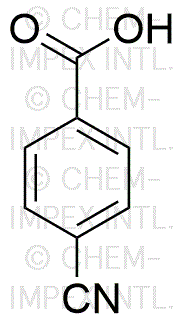4-Cyanobenzoic acid is widely utilized in research focused on:
- Synthesis of Pharmaceuticals: This compound serves as a key intermediate in the production of various pharmaceutical agents, enhancing the efficiency of drug development processes.
- Polymer Chemistry: It is used in the synthesis of polymers, particularly in creating high-performance materials that exhibit improved thermal and chemical stability.
- Organic Synthesis: Researchers leverage its reactivity in organic synthesis to create complex molecules, making it valuable in academic and industrial laboratories.
- Analytical Chemistry: This compound is employed as a standard in chromatographic methods, aiding in the accurate quantification of other substances in complex mixtures.
- Material Science: Its properties make it suitable for developing advanced materials, such as liquid crystals and coatings, which are essential in electronics and optics.
General Information
Properties
Safety and Regulations
Applications
4-Cyanobenzoic acid is widely utilized in research focused on:
- Synthesis of Pharmaceuticals: This compound serves as a key intermediate in the production of various pharmaceutical agents, enhancing the efficiency of drug development processes.
- Polymer Chemistry: It is used in the synthesis of polymers, particularly in creating high-performance materials that exhibit improved thermal and chemical stability.
- Organic Synthesis: Researchers leverage its reactivity in organic synthesis to create complex molecules, making it valuable in academic and industrial laboratories.
- Analytical Chemistry: This compound is employed as a standard in chromatographic methods, aiding in the accurate quantification of other substances in complex mixtures.
- Material Science: Its properties make it suitable for developing advanced materials, such as liquid crystals and coatings, which are essential in electronics and optics.
Documents
Safety Data Sheets (SDS)
The SDS provides comprehensive safety information on handling, storage, and disposal of the product.
Product Specification (PS)
The PS provides a comprehensive breakdown of the product’s properties, including chemical composition, physical state, purity, and storage requirements. It also details acceptable quality ranges and the product's intended applications.
Certificates of Analysis (COA)
Search for Certificates of Analysis (COA) by entering the products Lot Number. Lot and Batch Numbers can be found on a product’s label following the words ‘Lot’ or ‘Batch’.
*Catalog Number
*Lot Number
Certificates Of Origin (COO)
This COO confirms the country where the product was manufactured, and also details the materials and components used in it and whether it is derived from natural, synthetic, or other specific sources. This certificate may be required for customs, trade, and regulatory compliance.
*Catalog Number
*Lot Number
Safety Data Sheets (SDS)
The SDS provides comprehensive safety information on handling, storage, and disposal of the product.
DownloadProduct Specification (PS)
The PS provides a comprehensive breakdown of the product’s properties, including chemical composition, physical state, purity, and storage requirements. It also details acceptable quality ranges and the product's intended applications.
DownloadCertificates of Analysis (COA)
Search for Certificates of Analysis (COA) by entering the products Lot Number. Lot and Batch Numbers can be found on a product’s label following the words ‘Lot’ or ‘Batch’.
*Catalog Number
*Lot Number
Certificates Of Origin (COO)
This COO confirms the country where the product was manufactured, and also details the materials and components used in it and whether it is derived from natural, synthetic, or other specific sources. This certificate may be required for customs, trade, and regulatory compliance.


